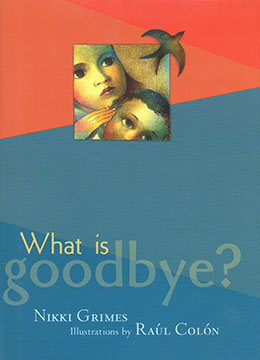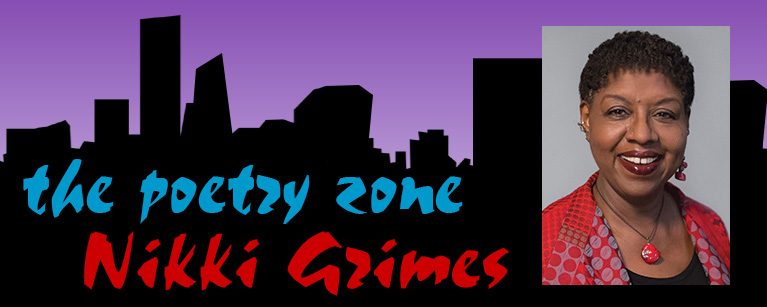
written by Nikki Grimes
illustrated by Raul Colón
Hyperion Books for Children, 2004
Find this book at your favorite library or used bookseller.
What is Goodbye?
From the Book
Why? Jesse
Why did Jaron have to die?
I asked till my lips burned dry.
Mommy sighed and shook her head.
“God scoops up the good,” she said.
Then, from now on, I won’t be.
Hear that God? Don’t come for me.
Why? Jerilyn
Why give God
a bad name?
Why not blame
the moon,
if you must pretend
to have an answer?
We both know sense
is like shadow.
Chase it till you sweat,
and all you’ll get
is a handful
of nothing.
Besides, what difference
does it make?
Just concentrate
on breathing.
from What is Goodbye?
© 2004 by Nikki Grimes
Listen to Nikki Grimes read “Night Noise” from What is Goodbye?:
Awards and Recognition
- BALA Notable Book 2004
- Bank Street College of Education Best Children’s Books of the Year
- Capitol Choices
- CCBC Best Choices 2005
- Chicago Library Best of the Best Books for Kids
- NCTE Notable Book 2005 (Children’s Literature Assembly)
- New York Public Library 100 Books for Reading and Sharing
- Notable Children’s Books in the Language Arts
- Parents’ Choice Silver Honor Award 2004
- School Library Journal Best Books 2004
Resources
Reviews
Insightfully and concisely, Grimes (Bronx Masquerade) traces the stages of grief and healing, through the 26 paired poems of two siblings mourning their older brother, Jaron.Jesse, “too young” to go to the funeral, expresses loss in raw terms; his poems always lead the pairings.His sister, Jerilyn, is older than Jesse, but younger than Jaron, she tends to hide her hurt.Anyone who has experienced loss will recognize the gamut of emotions Grimes lays out here. Jesse expresses that momentary forgetfulness when he first wakes in “The Day After.”“Saturday is here at last./ Time for soccer!What a blast” and several lines later, his realization, “Do I have to mow the lawn?/It’s not my turn.Oh.It’s—… In the excellent juxtaposition for “His Name,” Jesse uses a flurry of words, while Jerilyn contrasts the meaning of Jaron’s name (“to sing”) with the silence since he’s been gone… Both siblings observe the changes in their home, and when the family begins to come together again, readers who grieve will feel that they can recover, too.” (Publishers Weekly, starred review)
People of all ages have long turned to poetry as a way to express profound emotions of grief. Award-winning author Nikki Grimes, who lost her father when she was 15, calls upon those memories in her new book for children and teens.What Is Goodbye? is a story in poems, elegantly designed and beautifully illustrated by Raul Colón. The poems are narrated in two voices, from the points of view of a brother and sister whose older brother has suddenly died.The poems take the reader through the familiar painful process we all experience when a loved one dies.There are poems titled “The Next Day,” The Funeral,” and “The Awful After.“As time passes, Jesse and Jerilyn recount their reactions to the “First Day Back,” the changed family dynamics at dinnertime and their anger at Jaron for leaving.By the end of the story, an entire year has passed.As the children pose with their parents for a new family photograph, they have begun to feel that even though one piece will always be missing, their family is nevertheless whole once again.Together Grimes and Colón have created a lovely and poignant book that is sure to be embraced by readers of all ages.” (Bookpage)
Grimes novella in verse is a prime example of how poetry and story can be combined to extend one another.When their brother dies, Jerilyn and Jesse cope with the anger, confusion, and the silence that grief brings to their family. Jesse’s rhyming verse faces his older sister’s free-verse comments on her experiences. When Jesse hits a home run in a league game soon after his brother’s death, he glows, “I took off around the field,/legs pumping like lightning/I slid into home plate clean./Man, I’m so cool,/I’m frightening!/…What am I supposed to do,/spend each minute crying?/I wish I could please you, Mom,/but I’m so sick of trying.“Jerilyn muses, “It’s his right to smile,/isn’t it?/ To be delirious?/So what if I don’t understand?/This ghost town,/draped in shadow,/is desperate for/a few more watts of light.” Grimes handles these two voices fluently and lucidly, shaping her characters through her form. Colón’s paintings in muted colors combine imagism with realism to create an emotional dreamscape on nearly every page. The clean design combined with the book’s short, easy pace and small size give readers a comfortable place from which to listen to the characters as they make their way from “Getting the News” to“Anniversary,” and finally “Ordinary Days.“The book closes with a poem in two voices, and Jesse and Jerilyn come together for a new family photograph. “Smile!” — and readers will. Fans of Vera B. William’s Amber Was Brave, Essie Was Smart (Greenwillow, 2001) will appreciate this powerful title. (Nina Lindsay, Oakland Public Library,CA, School Library Journal, June 2004)
Find this book at your favorite library or used bookseller.


